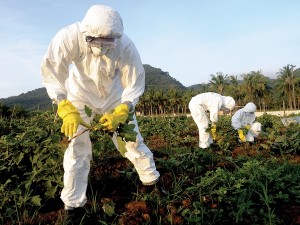
Activists in hazmat (hazardous material) suits from the environmentalist group Greenpeace uproot genetically engineered Bt eggplant, locally known as ‘‘talong,” from a field trial site in Bay Laguna province, in this 2011 photo. FILE PHOTO
MANILA, Philippines—Greenpeace proposed on Friday that the government take the rehabilitation and reconstruction of areas devastated by Supertyphoon “Yolanda” (Haiyan) as an opportunity to build climate-resilient communities powered by renewable energy.
The environment group cautioned the government against repeating the mistakes of the past, as it advised newly appointed rehabilitation head Panfilo “Ping” Lacson to consider the work ahead as a chance to establish sustainable communities using renewable energy systems.
“Yolanda caught us completely unprepared, forcing us to deal with serious consequences of climate change,” said Amalie Obusan, regional climate and energy campaigner for Greenpeace Southeast Asia.
“Aside from the human tragedy, we also have to deal with the socioeconomic impacts. Because the work ahead is massive, critical decisions will be made for the reconstruction and repair of energy systems in the devastated provinces. And this is where RE (renewable energy) can make a difference,” she said in a statement.
Typhoon “Yolanda” caused an estimated P35 billion in losses and damage to public infrastructure and agriculture. Power systems are mostly down with 1,959 transmission facilities partially or fully destroyed, according to Greenpeace.
Greenpeace said solar panels can make a huge difference in disaster-hit areas, when power lines are down for many days, if not months.
“There would be cost savings for the entire archipelago, and the size of the savings would be commensurate to the number of households and businesses whose partial or total energy resilience would make them suffer less in the aftermath of storm-induced blackouts,” it said.
Obusan said a decentralized energy system, through renewable energy was needed to power communities, especially those living off the main grid.
She cited as an example small-scale solar energy systems that could “foster a small-town energy revolution by and for people, families, communities, farms, and small and medium-sized businesses.”
Greenpeace also recommended the following for the rebuilding and rehabilitation of Eastern Visayas:
- Light up communities through renewable energy technologies… Communities that are located outside of the nearest electricity service areas should be energized using stand-alone RE technology such as solar PV and microhydro systems.
- Include capacity-building for energy projects by creating partnerships with communities and providing technical assistance.
- Provide microcredit and consulting for the promotion of off-grid, decentralized RE technologies.
- Financially support local entrepreneurs who could either benefit from energy access or supply their communities with RE services.
- Institute an RE program in schools.
With RE-powered multimedia technology, teachers and students will have the opportunity for better teaching and learning conditions.
“The ongoing reconstruction will give the government an opportunity to rethink energy systems in these devastated areas,” Obusan said.
“We hope Mr. Lacson will listen to our advice and do what he can to turn this tragedy into an opportunity. Now is the time to rebuild our towns and cities using greener and sustainable energy systems that are climate-resilient,” she said.